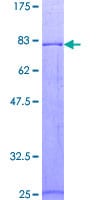Recombinant Human Protein C (ab159228)
Key features and details
- Expression system: Wheat germ
- Tags: GST tag N-Terminus
- Suitable for: ELISA, WB
-
Product name
Recombinant Human Protein C
See all Protein C proteins and peptides -
Expression system
Wheat germ -
Protein length
Full length protein -
Animal free
No -
Nature
Recombinant -
-
Species
Human -
Sequence
MWQLTSLLLFVATWGISGTPAPLDSVFSSSERAHQVLRIRKRANSFLEEL RHSSLERECIEEICDFEEAKEIFQNVDDTLAFWSKHVDGDQCLVLPLEHP CASLCCGHGTCIDGIGSFSCDCRSGWEGRFCQREVSFLNCSLDNGGCTHY CLEEVGWRRCSCAPGYKLGDDLLQCHPAVKFPCGRPWKRMEKKRSHLKRD TEDQEDQVDPRLIDGKMTRRGDSPWQVVLLDSKKKLACGAVLIHPSWVLT AAHCMDESKKLLVRLGEYDLRRWEKWELDLDIKEVFVHPNYSKSTTDNDI ALLHLAQPATLSQTIVPICLPDSGLAERELNQAGQETLVTGWGYHSSREK EAKRNRTFVLNFIKIPVVPHNECSEVMSNMVSENMLCAGILGDRQDACEG DSGGPMVASFHGTWFLVGLVSWGEGCGLLHNYGVYTKVSRYLDWIHGHIR DKEAPQKSWAP -
Amino acids
1 to 461 -
Tags
GST tag N-Terminus
-
Preparation and Storage
-
Alternative names
- Activation peptide
- Anticoagulant protein C
- APC
see all -
Function
Protein C is a vitamin K-dependent serine protease that regulates blood coagulation by inactivating factors Va and VIIIa in the presence of calcium ions and phospholipids (PubMed:25618265). Exerts a protective effect on the endothelial cell barrier function (PubMed:25651845). -
Tissue specificity
Plasma; synthesized in the liver. -
Involvement in disease
Thrombophilia due to protein C deficiency, autosomal dominant
Thrombophilia due to protein C deficiency, autosomal recessive -
Sequence similarities
Belongs to the peptidase S1 family.
Contains 2 EGF-like domains.
Contains 1 Gla (gamma-carboxy-glutamate) domain.
Contains 1 peptidase S1 domain. -
Post-translational
modificationsThe vitamin K-dependent, enzymatic carboxylation of some Glu residues allows the modified protein to bind calcium.
N- and O-glycosylated. Partial (70%) N-glycosylation of Asn-371 with an atypical N-X-C site produces a higher molecular weight form referred to as alpha. The lower molecular weight form, not N-glycosylated at Asn-371, is beta. O-glycosylated with core 1 or possibly core 8 glycans.
The iron and 2-oxoglutarate dependent 3-hydroxylation of aspartate and asparagine is (R) stereospecific within EGF domains.
May be phosphorylated on a Ser or Thr in a region (AA 25-30) of the propeptide. -
Cellular localization
Secreted. Golgi apparatus. Endoplasmic reticulum. - Information by UniProt











